5/5/12 - Saturday to Golan Heights - Peace Vista Lodge
After our breakfast in the hotel, we explored Nazareth, walking in the footsteps of Jesus—as well as Elijah, Deborah, Solomon, and many other Biblical figures.

Pat |
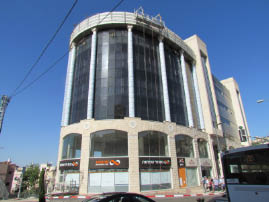
Hotel in Nazareth Golden Crown–Old City |
This town is very big on Mary. There are two separate churches claiming the annunciation – the place where Gabriel (the head angel) appeared to Mary to warn her she was “with child” without any “biblical action.” One was the Greek Orthodox and one the Roman Catholic. The Greek Orthodox Church of St. Gabriel’swas built over the site of the stream where believers claim Mary got the message from Gabriel. The massive Roman Catholic Church was built over the ruins of Mary’s house where other believers swear to God that Gabriel came to visit.
We first visited the cozy Greek Orthodox Church of St. Gabriel’s. We walked right into a church service with our flashing cameras and obnoxious American ways. We proceeded down to an alcove (really a basement) to see what remains of the spring where Mary got the news. They still use the water.
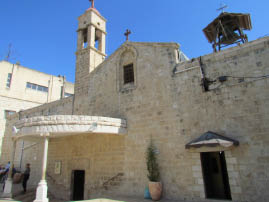
Church of St. Gabriel |

Church of St. Gabriel |
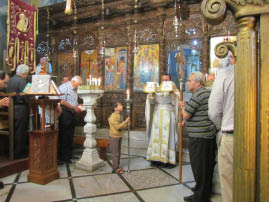
Church of St. Gabriel |
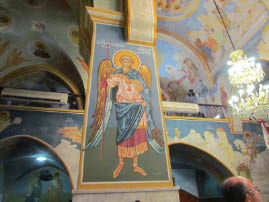
Church of St. Gabriel |
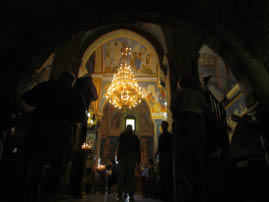
Church of St. Gabriel |
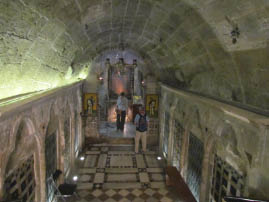
Church of St. Gabriel |
After we checked that site off our list, we walked through Nazareth to a Christian Synagogue Church, a small Greek Catholic church built on the ruins of the ancient synagogue where Jesus gave his first reading / sermon. (See Luke 4:16 for eye witness reports.) I couldn’t hear Yael’s explanation in the synagogue very well because of the echoes bouncing around those high arches. What I was able to make out was that the town didn’t take Jesus very seriously. He lived in Nazareth from age 3 or 4 until he was 30 and the townsfolk just remember him as a kid running wild through the streets. They never thought he’d grow up to be so famous. They thought he was just full of himself claiming to be God’s son and so on. In fact, at one time the people of Nazareth got so irritated with him, they marched him out of town and to the southern hilltop. There they tried to throw him off the hill. Mary saw it all. It was time for Jesus to leave Dodge – and he did! The hill is currently known as the “Leap of the Lord.” (Luke 4:29 – 30).

Synagogue Church |

Synagogue Church |
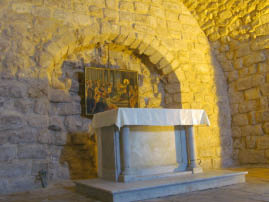
Synagogue Church |
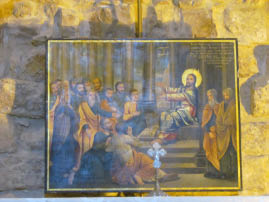
Synagogue Church |
Our next stop was the Basilica of the Annunciation, the Roman Catholic Church. It’s the 5th church built on this holy spot where Gabriel came to Mary (Luke 1:26 – 38). Some churches were destroyed while sections of the Byzantine and Crusader churches remain. Dedicated in 1964 by Pope Paul VI (and completed in 1969), the Basilica of the Annunciation is a massive modern church, topped with a lace-like concrete dome. It’s the largest church in the Middle East and consists of an upper church and a lower church.

Basilica of the Annunciation |
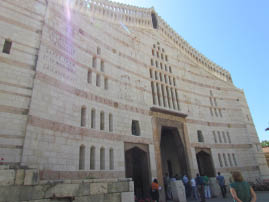
Basilica of the Annunciation |
Huge mosaics of the Virgin Mary donated by Catholic communities from around the world cover the place, both inside and out. It was amazing to see how the image of Mary is interpreted throughout the world.
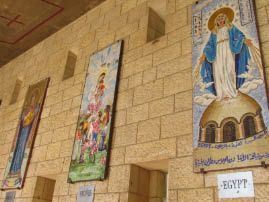
Basilica of the Annunciation |
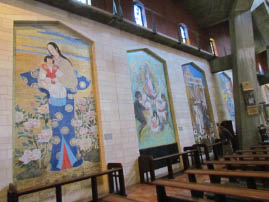
Basilica of the Annunciation |
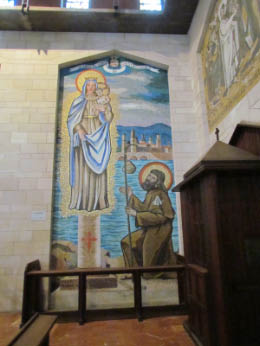
Image of Mary |
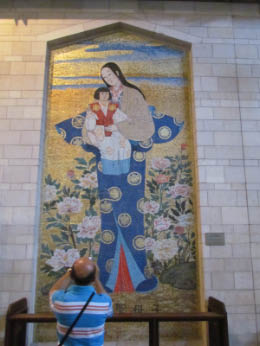
Image of Mary |
The massive doors had scenes from the life of Jesus -- reminded me of the doors from the Duomo in Florence. The church – nothing prepares you for the size – seemed bigger than a football field. From the upper section, we could look down into the dimly lit lower church housing the Grotto of the Annunciation, believed by many Christians to be the original childhood home of Mary where the angel came to visit. We exited into a courtyard where we could see more excavations of ancient Nazareth. I could have spent a long time exploring those ruins.
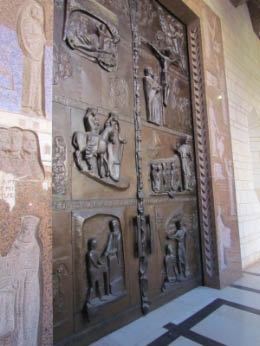
Basilica of the Annunciation |
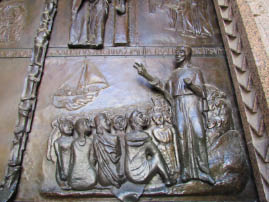 Basilica of the Annunciation Basilica of the Annunciation |

Basilica of the Annunciation |
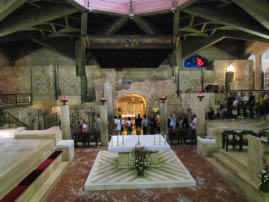
Basilica of the Annunciation |
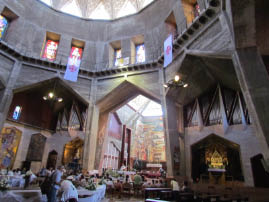
Basilica of the Annunciation |
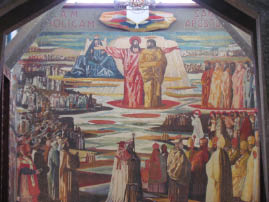
Basilica of the Annunciation |
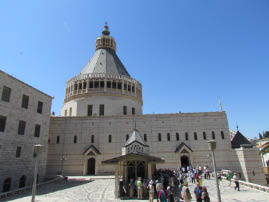
Basilica of the Annunciation |
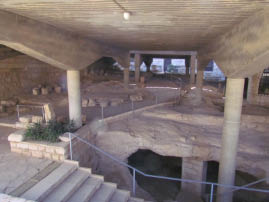
Basilica of the Annunciation |
Yael walked us through the marketplace, stopping to point out a sign meant to raise the ire of Christians (and other non-Islamics). It was poorly translated from the Qur’an “… whoever seeks a religion other than Islam, it will never be accebted (sic) of him, and in the Hereafter he will be one of the losers.” With little minds there is little acceptance and little hope.

Sign in Nazareth |
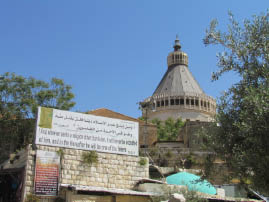
Nazareth |
We had some confusion in picking up Richard. Poor guy missed the morning tour of Nazareth. He was stricken by a bad bug and stayed back at the hotel. No one wanted to sit by him on the bus. He looked seriously infected.
We headed to the Golan Heights, stopping to explore ancient Tzippori (or Zippori) located in the lower Galilee, halfway between the Mediterranean Sea and the Sea of Galilee. Zippori, now a National Park, is a really impressive archeology site with tons of history:
- First settled by the Hasmoneans in the second century BC. Later, Byzantine, Arab and Crusaders left their ruins behind
- Was the Roman capital of Galilee through the reign of Herod
- Hometown of Virgin Mary’s parents, Anna and Joachim, and Mary’s birthplace
- Under construction during the lifetime of Jesus. It’s speculated that Joseph worked there as a builder and might have had his young apprentice, Jesus, lay a few stones.
- Described by the first century Jewish historian, Josephus Flavius, as "the ornament of all Galilee." (I would grow fond of Josephus and his wonderful, day to day descriptions of first century life in the Holy Lands.)
- Located on or near major trade routes in the lower Galilee, Zippori was a prime market for traders. Like most commerce centers, it became a rich, classy town – attested to by the mosaics, the buildings, the aqueducts and the number of oil presses and wine barrels left behind.
Yael bought our tickets and then we watched the orientation film. The film’s narrator and star was a sexy woman dressed in period dress -- veils and things -- telling the story of the woman’s image on the Byzantine mosaic floor. The mosaic is known as the ‘Mona Lisa of the Galilee.’ She has become the symbol for the Park. We’d see her later in the Roman House.
After the film, we entered the ancient synagogue with the well-preserved mosaics on the floor. In the center was a zodiac featuring Greek deities. Yael was pointing out the meaning embedded in the images -- the Covenant (from the past), the zodiac (astrology for present) and not sure what the Future promises because 3 of the most bratty kids were making a racket. Finally the mom took them out – and not a minute too soon.
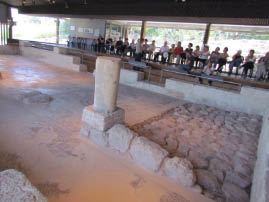
Zippori |

Zippori |

Zippori |
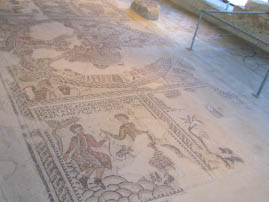
Zippori |
The ancient synagogue was at the Center of Jewish life in the 2nd century. At one time it was the headquarters of the Sanhedrin (the supreme Jewish religious and judicial body). Led by Rabbi Yehuda Hanasi, the first written codification of Jewish oral law (Mishnah) was compiled. The rabbinic sages must have burned the midnight oil turning out that code and setting the foundations for how the Orthodox Jews live today.
Outside, the place was covered in ruins. Yael pointed out that the town was built according to principals in a Roman City Plan (with a few variations). Structures and roads are placed according to specific directions – North / South / East / West. The main road in and out of town is along a north / south axis (with the marketplace tucked behind the road). Temple faces one way (towards Jerusalem, I believe), acropolis another way. I’ve seen this scheme in many ancient Roman cities.
The city’s system of underground cisterns and aqueducts was impressive with remains of huge reservoirs and pipes bringing water to the residents. We saw the theater – not as impressive as other theatres I’ve seen from the era. It was interesting to compare the ritzy side of town with the neighborhood where the plain folks live. Yael pointed out the simple ritual baths (with 7 steps leading down) installed in the simple homes. Ritual bathing is an absolute necessity.
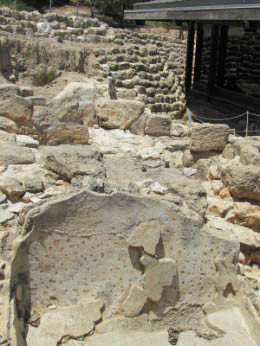
Zippori |
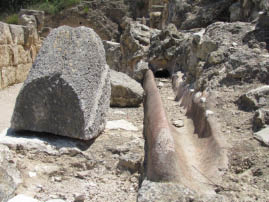 Zippori Zippori |
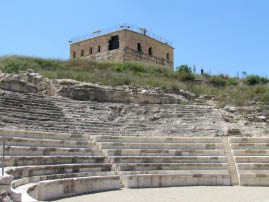
Zippori |

Zippori |
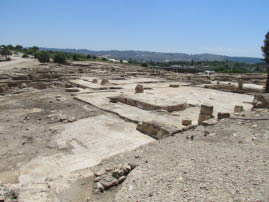
Zippori |

Zippori |
We looked out over the colonnaded roadways, the main arteries connecting the trade routes leading into town. Tucked along the roadways was the marketplace.

Zippori |

Zippori |
We hiked up to the Citadel on the hill. It has a long history of remodels. The watch tower was built during the Crusader period on the foundations from an earlier period. Some of the cornerstones are rubble-filled Roman Sarcophagi. Everything is recycled. In the 18th century, it was renovated by the Bedouin Ruler of Galilee. At the end of the Ottoman period it was rebuilt to use as a schoolhouse and then remodeled again during the British Mandate. I wanted to climb to the top for a view of the whole area, but some of the group got lost – so we turned back to gather them up.

Zippori |

Zippori |
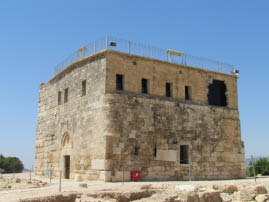
Zippori |

Zippori |
Our next stop was the Roman Villa (Dionysus House), once a palace and a party house. The mosaic floors celebrate the God of Wine. Also embed in the floor is the bewitching ‘Mona Lisa of the Galilee’ we learned about in the orientation film. Her eyes followed you as you walked.
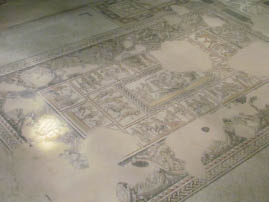
Zippori |
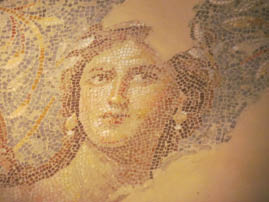
Zippori |

Zippori |

Zippori |
An indoor bathroom was close to the banquet area. That wild and crazy first century historian, Josephus Flavius, wrote, “Happy is the man whose latrine is close to the table.” You gotta love him.
Throughout the park, I noticed that the trash cans were buried in the ground. Yael said they were installed when she was a kid to help keep explosives from blowing up the locals. She was taught to throw any pipes or strange objects into these cans. If they were bombs, they would only explode upward, minimizing damage. Can you imagine growing up in such a world?

Zippori
|
Back on the bus, we discovered we had lost Gundra. Yael made a few runs (good thing she’s a runner) and then found her waiting at the Visitor’s Center.
We made a quick stop at a fast food falafel place. We were starving and it was delicious – but no beer!
The Church of the Beatitudes in the Region of the Sea of Galilee was next on our agenda. It was a very tranquil place with beautiful gardens and nice views of the Sea of Galilee. I was surprised how the eight Beatitudes (or blessings) from Christ’s Sermon on the Mount (Matthew 5-7) all came back to me (blessed are the poor, the meek, etc.)

Church of the Beatitudes |
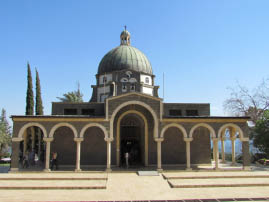
Church of the Beatitudes |

Church of the Beatitudes |

Church of the Beatitudes |

Church of the Beatitudes |

Church of the Beatitudes |
The church, run by the Franciscan Sisters (Italian), is built near the spot where they believe Jesus gave his famous sermon. Yael cautioned us not to get hung up on exact locations. The churches are built so that people can go on a spiritual pilgrimage.
I wasn’t crazy about the domed Roman Catholic Church. Designed by monk turned famous architect Antonio Barluzzi, the church was commissioned by Mussolini and completed in 1937.
We stopped at the Church of the Multiplications of the Loaves and Fishes but it was closed on Sunday – go figure. The church is supposedly built over the rock where Jesus laid the five loaves and two fishes that multiplied to feed 5000 followers (Mark 6:30-44).
Our last stop of the day was Capernaum, an ancient Roman fishing village and the town where St. Peter lived. For 3 years, Jesus stayed with Peter and established his ministry. He spread the word and recruited his first disciples here – local fishermen -- Peter, Andrew, James and John -- and the tax collector, Matthew. (“Follow me and I will make you fishers of men.” – Matthew 4:19.)
Yael said Capernaum had a thriving Christian community from the 2nd to 4th century, but after the Arab conquest around 700 AD the town was destroyed and never inhabited again. There was a section of grave markers. When the Romans conquered the place, like they always do, they built their new town over the graves – not a nice thing to do to the Christians. We saw what is believed to be St. Peter’s family grave marker. The family name with the symbol of a menorah was carved on stone. The menorah was the Jewish symbol developed in response to the Christian symbol, the cross, which replaced the fish. (I like the fish better.) It’s all about branding and marketing.

Capernaum |
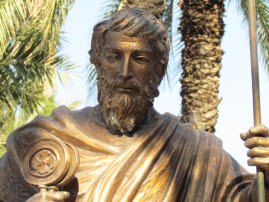
Capernaum |

Capernaum |
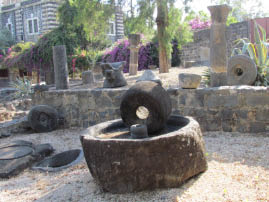
Capernaum |
We walked to the synagogue, built at least a century after the Crucifixion took place. It was made of limestone with remnants of large pillars with hints of carvings scattered about. The group was pretty much brain dead by that time. We sat along the benches lining the synagogue with blank stares in response to Yael’s wisdom. (Something about swine and pearls?)
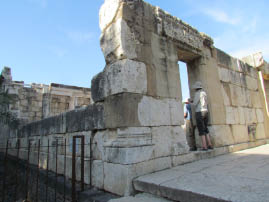
Synagogue at Capernaum |
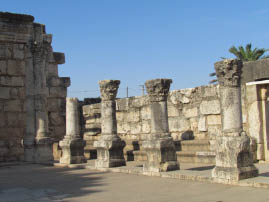
Synagogue at Capernaum |
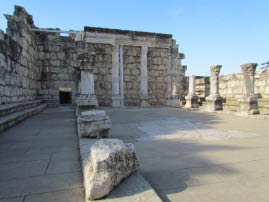
Synagogue at Capernaum |

Synagogue at Capernaum |
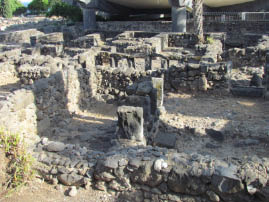
Synagogue at Capernaum |

Synagogue at Capernaum |
We walked to Peter’s house just as they were closing up, but we got a peek at the ruins. Of course a church is built over the ruins – practically a requirement for the Holy Lands. Wish I had tried harder to get a better picture. This is the place where Jesus stayed and where small groups of guys gathered to spread Christianity. It was here that Peter got the idea of meeting in homes, not the synagogue, to establish the new religion – wonder if he served refreshments.

St. Peter's House
|
Capernaum was a tough act for Jesus. He performed 80% of all his miracles right here (healing the sick, casting out demons, water into wine, etc.) and still, nobody believed in him. Eventually, Jesus had had it with the place and cursed the townsfolk big time before he moved on. See for yourself: Matthew 11:23-24.
It was a long, hot, action-packed day. We were thrilled to arrive at our cabins in the Peace Vista – very peaceful aura indeed overlooking the Sea of Galilee. The lodge named Kfar Haruv, is run by a Kibbutz and the porters are women who delivered us to our cozy cabin, #7. Wine was waiting for us on the coffee table. We showered and enjoyed our new place until we discovered our Debit Card missing. Turned out it wasn’t really missing after all; we had too much sun that day and weren’t thinking straight.

Peace Vista Lodge where the porters are women |

Peace Vista Lodge |

Our Cabin--#7 |
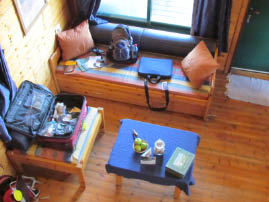
Inside Our Cabin--#7 |

Inside Our Cabin--#7 |
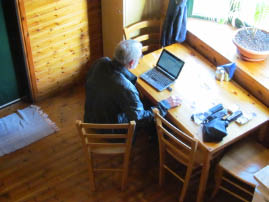
Peace Vista Lodge |
We didn’t have time to fret because we were back on the bus heading for the Kibbutz meeting place to learn about the history and the day-to-day life in this communal settlement. After a very dated propaganda--“everything is good”-- film, Luna, our host, told her story. She came to the Kibbutz 25 years ago with her husband. It was tough to get in, but after a year of temporary status, they passed the rigorous vote. She had 5 sons and life on the Kibbutz worked out for them. Her education was in science. She had planned to be a science teacher, but instead, she was assigned to cafeteria duties. She is now a healer adjusting energy centers and working outside the Kibbutz. The Kibbutz management collects the wages and the group decides how to allocate the funds. Last year they had enough funds to take the group on holiday to Turkey. Luna was a jolly, grounded, sincere woman. We all liked her. During the Q&A period, someone asked if we should worry about Syria attacking us. With her thoughtful wit, she replied, “No, we’re sitting in a bomb shelter right now” – and we were!

Luna at the Kibbutz |
We had dinner at the Kibbutz – split pea soup to die for – then we walked back in the dark, along the cliffs overlooking the Sea of Galilee (if we could see) to our little cabin #7.
NOTE: It was Zion’s birthday today – I miss her terribly and hope that she’s having a great slumber party at her other grandma's with her girlfriends and her dog Molly.
5/6/12 - Sunday - Golan Heights / Peace Vista Lodge
Bill was up early for a run in the Peace Vista Reserve. He was back and showered by 7:30 when breakfast was delivered to our cabin. (It was delicious and big enough to cover dinner as well).
I went out to soak in the peaceful morning vibes of the Peace Vista, made all the more peaceful by the friendly dogs out to greet you with their unconditional love.
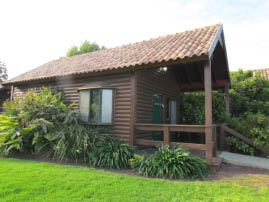
Our Cabin--#7 |

View of Sea of Galilee |
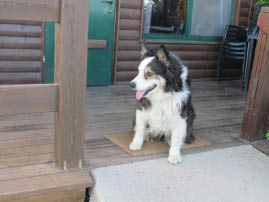
Peace Vista Dogs |
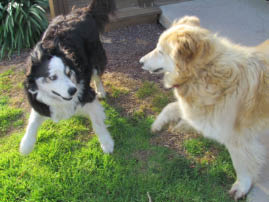
Peace Vista Dogs |
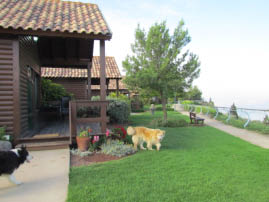
Peace Vista Lodge |
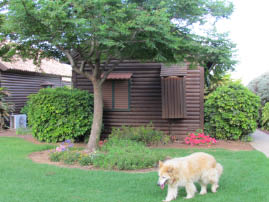
Peace Vista Lodge |

Peace Vista Lodge |

Peace Vista Lodge |
The peace didn’t last very long as we dashed to the bus and took the front seat. Turned out to be a bad idea. The leg room was limited and the driver had really bad B.O., but he kept his arms down most of the time suppressing the odor molecules that would drift back into our nostrils.
Looked out the bus window and couldn’t believe we were actually in the Golan Heights. It’s nothing like I had imagined from the war stories we hear in the U.S. It’s 12 miles wide by 48 miles long and overlooks a huge valley and the Sea of Galilee. It’s filled with spas and wineries and orchards and vineyards and peaceful Israeli farming communities with lots of fat, happy cows.

Golan Heights |

Golan Heights |

Golan Heights |

View from our front row seats |
Until 1967, the Golan Heights was part of Syria. There are reminders like bomb shelters and tank barricades that this place wasn’t always peaceful. When occupied by Syria, they sent salvo after salvo of bombs and missiles raining down on the Israelis below.
After getting a look at the Golan Heights, I wondered how people the peace negotiators could ever consider that Israel give this territory back. It's not because of the beauty of the Golan Heights (although it is beautiful) but because of its strategic topography making it absolutely necessary for Israel to control this piece of land for her safety. (Pardon the diversion – We have a lot of political discussions on the bus which triggers such thoughts.)
The first stop of the day was in the Gamla Nature Reserve -- a wonderful combination of Nature Reserve, ancient city (Gamla) and the highest waterfall in Israel (which we missed).
We started our visit with the ancient fortress captured by the Romans -- Gamla. The name, “gamal,” comes from the Hebrew word for camel because the ancient fortress was on a mountain shaped remarkably like a camel’s hump.
My new hero, the first century Jewish historian, Josephus Flavius, is a big part of Gamla. Josephus was actually in Gamla and served as a Commander of Galilee. In his writings, he used camel-rhetoric to describe Gamla’s location, referring to the camel’s head, hump (hilltop), tail, ribs, etc. With camel-riddles from the first century, archaeologists went nuts trying to find the city’s actual location. They finally found it in the late 1970’s when excavation begun. (According to one source, Gamla was excavated by archaeologists Shmarya Gutmann and Gal Itzhaki from 1967.)
Yael told us a little history of the place as we peered at that ancient ruin located on a high, camel-shaped mountain with surrounding ravines on all sides except one.
Gamla was originally settled in the early bronze age and in the 2nd century BCE, it became a civilian settlement. Over the centuries conquerors came and went.
Jews fleeing from persecution built Gamla into one thriving metropolis. They built a synagogue and dug cisterns to let water flow from place to place. Most people lived in terraced houses on a sloping hillside. The main industry and source of wealth was in olive oil production. The oil was sold to faraway places like Jerusalem. A class of rich merchants built neighborhoods in the west filled with grand homes.
Making it even more desirable, Gamla was located on the main road between Israel and Jewish centers in Babylon. The Romans wanted it and made no bones about it. It wasn’t the easiest location for Romans to attack, having only one entrance, nor was it so easy to excavate in later years.
In the early 60s CE, 30,000 Roman troops, led by Vespasian, landed in Akko, a seaport, and began their invasion on the Galilee and the Golan before heading down to Judea and Jerusalem. Because of these coming invaders, many Jews (about 10,000 people) went to Gamla for safety, making the city very crowded.
The first Jewish revolt against Rome began in 66 CE. Josephus, both a historian and a Commander of Galilee, started to reinforce the city by sealing passages, thickening walls, filling some rooms with stones, cutting trenches along the outside walls, and incorporating the high tower into the wall, as a way to see incoming invaders.
The war between the Romans and the Jewish rebels in Galilee reached its peak at Gamla. The city, preparing for war, was fortified on its eastern side. The Romans were defeated in the first battle, but came back and conquered Gamla in the second. This was only the beginning of the First Jewish Revolt against Rome which ultimately led to Jerusalem and the Temple’s destruction.
More details of the battle in Gamla – Skip it if you’re on overload …
In the Spring of 67 CE, Vespasian began his attack on Gamla. The troops broke through the city wall, but the Jews fought on, eventually retreating to the upper ground of the city. As the Romans followed them, the Jews turned around and began to attack. The Romans turn to flee and many crowded on the roofs of hillside houses. Their weight forced the houses to collapse, leaving many dead. The Jews took the Roman swords and fought on with the remaining fleeing Romans. It was a great victory – but the battle wasn’t over.
The Jews in Gamla were running out of provisions and started dying of hunger. Vespasian and the Romans knew this and waited a bit before their second siege. At night, a few Roman soldiers removed the stones forming the base of the tower, causing the tower to collapse. The next morning, Titus, Vespasian’s son, led troops in and chaotically began to fight the hopeless Jews. It was a ruthless fight, according to Josephus, “For at that moment the rage of the Romans was such that they spared not even infants, but time after time snatched up numbers of them and slung them from the citadel” Thus, Gamla fell.
Josephus writes the Romans slew 4000 people, while another 5000 killed themselves by jumping off a precipice rather than be taken slaves by the Romans. The revolt started on October 12, 67 CE and ended on November 10, 67 CE where three people – one man and two women – survived by hiding among the ruins. Vespasian would go on to become Emperor of Rome in 69 CE. |
We walked along a trail littered with abandoned ancient oil presses from the Byzantine period. Olive oil put Gamla on the map in the ancient world. Yael described the olive oil production process. First a donkey walked in circles; turning the wheel to crush the olives in the basin. Then a flat press extracted the rest of the oil from the olives – a mighty big business – way back when.
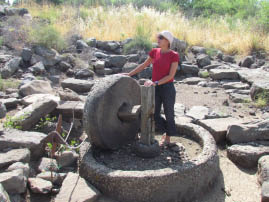
Yael explaining the olive press |
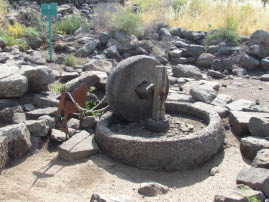
Olive press |
Next, we visited the bird pavilion dedicated to birds of this area – Egyptians vultures, Short-toed eagles, Long-legged buzzards, Boneli’s eagles and Griffon vultures. The nature reserve is doing its best to keep the Griffon vultures from becoming extinct. The once numerous and large vultures are mentioned in the Bible 28 times. They feed on carcasses and are known as “nature’s janitor” because they eat the dead and prevent the spread of disease. Over the past few years, only 60 pairs of the Griffon vultures were observed breeding in Israel.
The reserve built an acclimatization cage to hold, observe and re-introduced the young Griffon Vultures back into nature. They will be released in a few years. They were hatched from eggs removed from their nests and incubated as part of the vulture program. Hand puppets that look like Griffon Vultures are used to feed the hatchlings. The cage is placed on the edge of the Gamla cliff to give the young vultures a good view of the landscape where their colony lives. It sounded much like the program we had in California to save the California Condor – and guess what, it’s working with the California Condors!
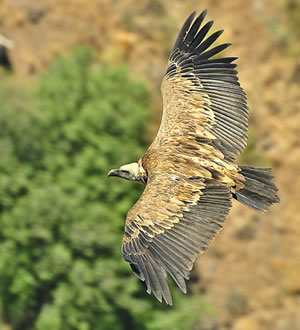
Griffon Vulture |
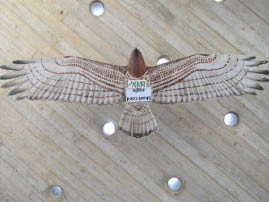
Griffon Vulture |
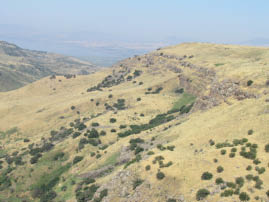
View from Bird Pavilion |
We walked through another village. Deir Qeruh was a thriving Christian village built between the 4th and 5th centuries. A church and monastery were added in the 6th century. In the mid-7th Century, the village was abandoned in the wake of an Arab conquest. Life came back to the village during 13th and 14th centuries and after a time gap, it became a Syrian village in the 20th century. Wouldn’t you know it, it was abandoned again during the Six Day War in 1967. Since it’s part of the Gamla Nature Reserve, it’s doubtful people will ever live in this town again.

Deir Qeruh Village |

Deir Qeruh Village |
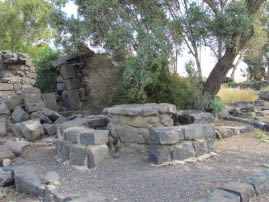
Deir Qeruh Village |

Deir Qeruh Village |
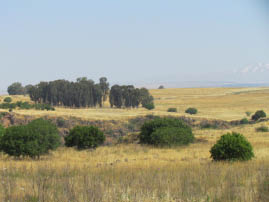
Gamla Nature Reserve |
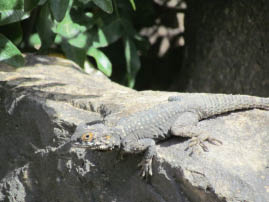
Israeli lizard |
We said good-bye to Gamla and headed down the road. We stopped for some wine tasting at the Golan Heights Winery. Our host was the cutest little Jewish guy who presented the choices with such flare. “Do you taste the honey? The apricot? The Buttery flavors?” Then he’d say, “Wines are made of grapes. Your imagination adds the rest.”
NOTE: A few months later, back in the states, I found that Ralph’s supermarket was clearing out the last 6 bottles from this very winery. I nabbed them. Can’t wait for six special events to pop the cork(s).
We said good-bye to Gamla and headed down the road. We stopped for some wine tasting at the Golan Heights Winery. Our host was the cutest little Jewish guy who presented the choices with such flare. “Do you taste the honey? The apricot? The Buttery flavors?” Then he’d say, “Wines are made of grapes. Your imagination adds the rest.”
NOTE: A few months later, back in the states, I found that Ralph’s supermarket was clearing out the last 6 bottles from this very winery. I nabbed them. Can’t wait for six special events to pop the cork(s).
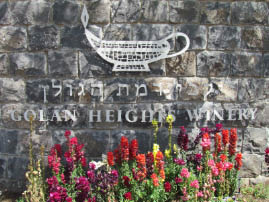
Golan Heights Winerary |

Golan Heights Winerary |
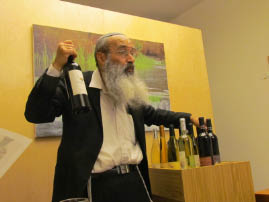
Our host at the winerary |

Bill checking out the wines |
We stopped at the Valley of Tears overlook to see the battlefield from the Yom Kippur war of 1973. It was difficult to imagine that such fighting and killing could take place in the valley now filled with orchards and dotted with towns.
Yael gave us some history of this sought-after place. Until 1967, the Golan Heights was part of Syria. The Six Day War changed all that when Israel was attacked from four fronts, including from the Golan Heights. The Israelis were greatly outnumbered but, had a formidable force on their side and we all know that they drove back their attackers in a most decisive way. Israelis even surprised themselves. The war made them over confident and cocky. Here they were, a new country, managing a slew of immigrants, and yet they easily defeated Egypt and Syria and in just six days. (We remember it well back from our University of Texas days. It was the topic of the day for Bill (who has some Jewish heritage) and his roommate Farouk, just off the boat from Syria. No fist fights -- Farouk embraced being an American the minute he set foot on US soil.)
That Six Day War really pumped up Israelis. They took their eye off the ball and were totally unprepared for the Yom Kippur War of 1973. The Russians had been outfitting Syria with tanks, night vision gear and training – lots of it. The attack came as the young soldiers were heading home for the holidays. Then, there was no quick communications to get the boys (and girls) back and on the battlefield. Golda Myer was caught with her pants down. She was defeated as prime minister shortly thereafter. The phrase: “Pride cometh before the fall” sprung to mind. (Kinda sad, I rather like Golda.)
When we were driving through the valley, the bus, from time to time, had to go through barricades on the main road. The bus driver had to come to a complete stop and make a series of sharp turns. Tanks couldn’t possibly fit through these mazes. On either side of the barricades were lines of bunkers further blocking tank action. The road through this peaceful, lush orchard and farmland had been retrofitted to keep war at bay.
We stopped in a Druze village near the border of Syria where we had lunch and a chance to learn more about the Druze community. Our Druze host, Hosia, was one amazing woman. The Druze are an Arab religious community that have separated from mainstream Arab nationalism, opting to serve in the Israeli Defense Forces. In the past, the Druze seemed radical for their belief in equality between men and women, the abolition of slavery, and separation of church and state. They also believe in education. This has served Hosia (our host) and her family well. The newly remodel living room, crowned by a huge TV and wedding pictures of the kids was beautiful. Before lunch, Hosia, age 61, told her story that touched our hearts. She gave her talk in Hebrew while Yael translated.
She was married at age 16. She was the only girl in a large family and brighter than her brothers. However, unlike her brothers, she was denied the opportunity to go to college because she was a girl. Her job was to do the chores around the house. At 16, she married a neighborhood man who was 24 at the time. It was her chance to get out of the house. On the wall next to her was a picture of a young freighted girl on her wedding day. That image is seared into my brain. I look at her now and know “the rest of the story.” This strong, empowered woman is reaping the benefits of a life that was once filled with struggle.
She has five children – a source of great pride for her. Four of them are married (large poster sized pictures of beautiful brides and grooms line the walls). Some of them children (smiling baby pictures are sprinkled everywhere). All are educated – there’s a film director, veterinarian, two teachers, and a computer scientist. Two of them live in the United States.
Education rules in Druze-land, especially in this town. From all of Israel, the highest percentage of students from Hosia’s town go on to college. Druze also believe that they should marry someone from their own village and their own sect. If they don’t, they are excommunicated from their family.
Hosia told us about the time she learned she was pregnant with baby #5 (the one who would become the computer scientist). She was old (late 30’s) and feared that the baby would have problems. She went to the doctor asking for an abortion. He helped her put her fears aside. Now she’s so happy to have that son.
When she was 50, she started a business – home hosting groups from other countries and has become very successful. At age 50 she learned Hebrew and is now learning English.
Her husband has a farm and spends most of his time there – not watching that big screen TV. Hosia prefers the smell of perfume to the smell of goats. She was agile, graceful and served a delicious lunch. She bounced up and down from a seated position while most of us, sitting on the floor, struggled up for seconds. We all left with full hearts and full tummies.

Druze Village |
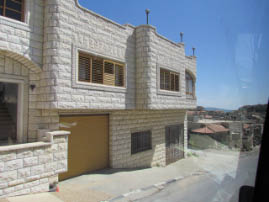
Hosia's house |
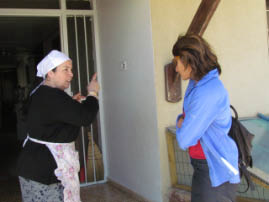
Hosia and Yael |

Hosia and Yael |
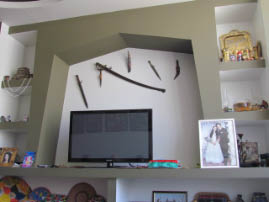
Inside Hosia's house |
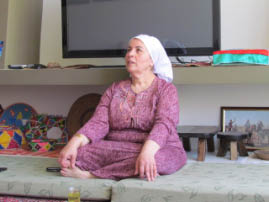
Hosia |
The next stops were at a couple of kibbutz’s – one that does the English subtitling for films and one that makes chocolates (located in Ein Zivan, Golan Heights). I always thought that a kibbutz was associated with communal farming left over from the socialism of the 1960’s. Boy was I wrong. Kibbutz can be any kind of business. Some of these businesses have done so well and have become privatized.
We went to Kibbutz El Rom, a film studio specializes in sub-titling movies. In the visitor’s center, we watched “Oz 77” a 22-minute film (with English subtitles, of course) about a tank battle between the Israelis and the Syrian Army here in 1973. This fierce battle took place in the Valley of Tears, right down the road. We heard the actual radio communications between Israeli tankers the night they were surrounded by hundreds of Arab tanks. Hearing the fear in their voices as they shouted commands and directions to one another, you knew what it must have felt like that night looking Death in the eye. War is so barbaric. We all left feeling down.
De Karina helped drown our sorrow in chocolate. The chocolate factory was established several years ago by Karina, an Argentinian immigrant. During WWII, three generations ago, her family left Israel for safety in Argentina where they learned the chocolate business and started a business. Karina returned to Israel a certified chocolatier and brought the family business back home to Israel.
The Kibbutz workers at the factory are so darn happy and lifted our spirits along with the delightful tasting chocolate. We started the tour with a nicely done orientation that gave a succinct history of chocolate--started in South America, then spread to Europe through Cortez in the 1500’s.
All the chocolate here is handmade (no machines). In one room we weren’t allowed to photograph trade secrets. After watching the skilled hand work of 4 of the workers, we went into the tasting room. We woofed down trays of chocolates and then, all revved up, we hit the gift shop.
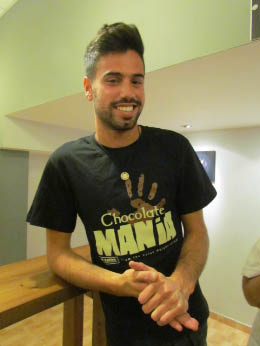
De Karina Chocolates |
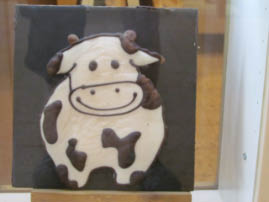 De Karina Chocolates De Karina Chocolates |
As we got closer to our home at Peace Vista, we made another Kibbutz stop – this time a grocery store. We got cheese, beer and a magnum for Bill.
It was nice to have the evening on our own at this peaceful place. We took a long walk along the cliffs overlooking the Sea of Galilee. I took wonderful pictures of the sunset – only to learn later that my camera was set for small pictures. How does that happen?!?!
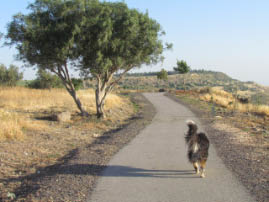
Peace Vista Lodge |
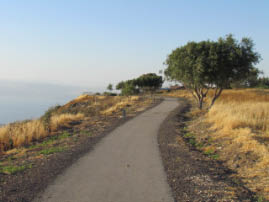
Peace Vista Lodge |
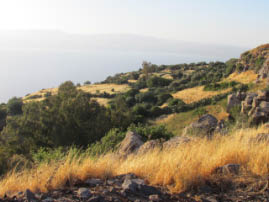
Peace Vista Lodge |

Peace Vista Lodge |
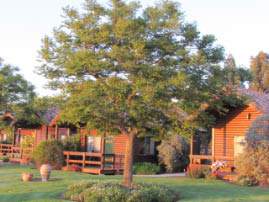
Peace Vista Lodge |
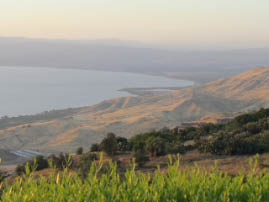
Peace Vista Lodge |
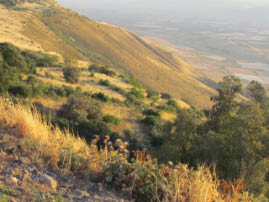
Peace Vista Lodge |
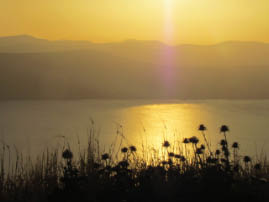
Peace Vista Lodge |
5/7/12 - Monday - to Jerusalem
After another big breakfast delivered to our cabin, it was time to pack up and say good-bye – so sad – best place we’ve stayed. We headed to the ancient city of Safed (also spelled Safed, Zefat, Tsfat, Zfat, Safad, Safes, Safet, Tzfat, etc.), filled with spiritual people and artists. It’s a small town (population 27,000) located high in the mountains of Upper Galilee with views to the Golan Heights. In fact, it’s the highest town in all of Israel -- 3200 feet above sea level. Perched on a scenic hilltop, it’s very picturesque with narrow winding cobblestones passing by medieval synagogues and of course, the ruins of a Crusader fort.
Safed is a mystical town founded in 70 AD. According to legend, sometime after the 2nd Century war when the second temple in Jerusalem was destroyed, Shem and Ever (son and grandson of Noah) came to a cave in the hills outside Safed. They spent 12 years praying while buried from the head down. They came up with the core text of Kabbalah mysticism while food and water was somehow being provided. The word of this miracle and the secrets of Kaballah spread. Today, people from all backgrounds celebrate the miracle, Lag Ba'omer, the most mystical day of the Jewish year. They get their 3-year-old boys hair cut for the first time and go nuts lighting fires. This is an annual affair that falls on what many believe to be the anniversary of Rabbi Shimon Bar Yohai's death, buried on Mt. Meron. It’s a nightmare for fire departments. Tens of thousands even trample up to his grave leaving bon fires everywhere.
In 1492, King Ferdinand and Queen Isabella (you know -- the guys who bankrolled Columbus) kicked out all the Jews from Spain. Spanish Jews fleeing the horrors of the Inquisition dashed to Safed. Many of the top Jewish religious scholars and mystics came along to establish yeshivas and synagogues. Safed continues its pull on Jewish immigrants looking for home. Thousands of Russian and Ethiopian have come in the past decade.
Safed flourished in the 16th century as a trade center and a spiritual center of Jewish mysticism—or Kaballah. Safed is one of the four holy cities in Israel, together with Jerusalem, Hebron and Tiberias.
In 1578, the first printing press in the Middle East was set up and printed the first Hebrew book released in Israel. Safed reached the height of glory in the 16th century, but then came a string of bad luck -- earthquakes, plagues and Arab attacks. Now things are turning around for Safed. In fact, the liberation of Safed was one of the most dramatic episodes in the 1948 War of Independence.
Yael told us that the Sabbath blessing first originated here. A group of local “do-gooder” mothers gave the travelers coming through Safed on their way to Jerusalem some food, blessings and a place to rest for a day. Somehow the idea stuck and Sabbath blessing found its way into Jewish tradition.
Yael also told us that Safed was the home of many Palestinians before the 1948 war, including Mahmoud Abbas, President of the Palestinian National Authority. Most of the Arabs left voluntarily, hoping to return after the Jews were defeated. Safed is now a Jewish town with a big Jewish soul. In 1948, David Ben Gurion give the town to the Jews, who were in the majority. They wanted it for a Holy City.
Before we explored the town, we stopped in at a candle shop with cleverly sculpted candles. (Yael’s mother use to work here.) Many of the candles depicted whimsical scenes from the Bible. (The shop, Safed Candles, is located on Najara St. near Ha’Ari Synagogue.)
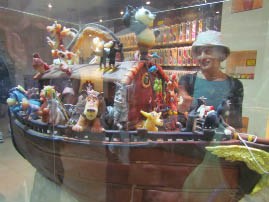
Candle shop in Safed |
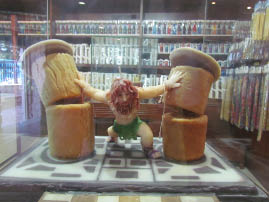
Candle shop in Safed |
We walked in the picturesque town. In the courtyard of the Ashkenazi Ari Synagogue is a column used for lighting small bonfires on the feast of “Lag Ba’Omer.” It’s for the sick and elderly who cannot join the procession with thousands to Mount Meron.
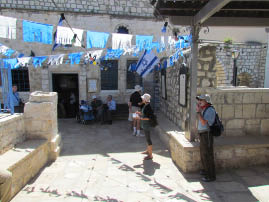
Ashkenazi Ari Synagogue |

Ashkenazi Ari Synagogue |
The Ashkenazi Ari Synagogue is a mid-16th century synagogue built by immigrants from Greece. It was named after the founder (Ha’Ari, for short) of Lurianic Kabbalah. He came to Safed in 1570 to join the ranks of other top dog mystics in this place.
The synagogue was destroyed in the Great Earthquake of 1837 and it took 20 years to rebuild it. One wall contains a Holy Ark (with its ancient Torah scrolls) carved in wood in the style of eastern European synagogues. I was intrigued by a carving of a lion on the Ark’s crown with a human face. It was supposed to represent Moses. That human face caused a stir because of the commandment: “Thou shall not make unto thee any graven image.”
In the 1948 War of Independence, shrapnel hit the side of the pulpit while the place was packed with people in prayer, yet no one was hurt. I got a photo of the shrapnel still imbedded in the pulpit.
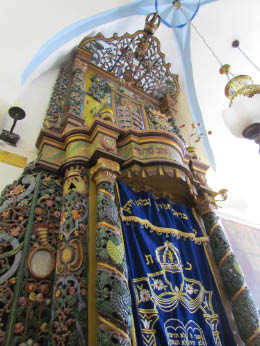
Ashkenazi Ari Synagogue |
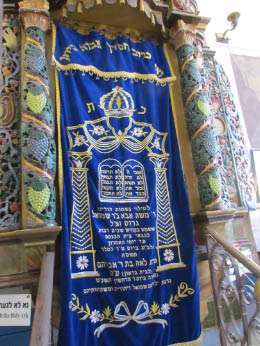
Ashkenazi Ari Synagogue |
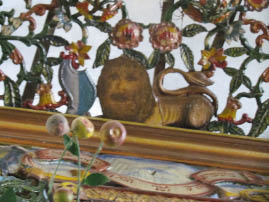
Ashkenazi Ari Synagogue |

Ashkenazi Ari Synagogue |
We had 20 minutes to shop in the artist colony. I was taken by the beauty of the place and clever artwork with lots of humor – should have bought something.
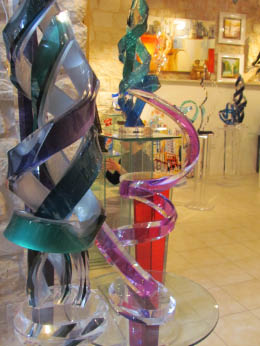
Safed Shop |
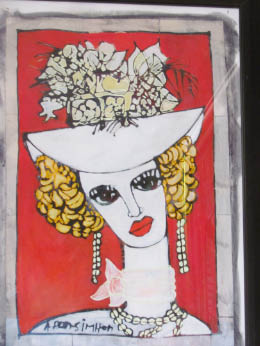
Safed Shop |
 Safed Shop Safed Shop |
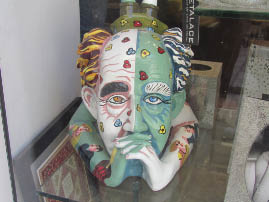
Safed Shop |
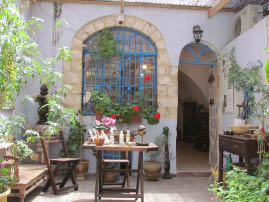
Safed Shop |
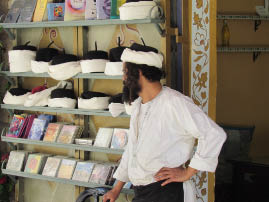
Safed Shop |
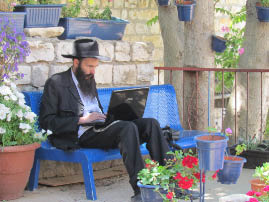
Safed |

Safed |
After checking Safed off our list, we headed downhill, less than ten miles to The Sea of Galilee. The Sea of Galilee, known as Lake Kinneret in Israel, is about 700 feet below sea level and the lowest freshwater lake in the world. This lake supports Israel’s life and agriculture today, just as it did in the past. It’s the only sweetwater lake in Israel and a national asset with its ability to store and supply scarce water for drinking, for agriculture, and for industry. Jesus’ early ministry began in the Sea of Galilee and the first disciples he recruited were fishermen. They were a rough crowd back then (kind of like the construction guys who remodeled our house, I would imagine).
We boarded FAITH, a boat from the Sea of Galilee Worship Boat Fleet, for a 30-minute boat ride, just to get the feel of the place. The crew raised the American flag alongside the Israel flag just as a military-looking helicopter was flying over. Once the flags were in place, the loud speaker blared out our national anthem. At first I wanted to keep it quiet that a group of vulnerable Americans were out at sea (or excuse me, out at Lake), but right after the words, “Oh say can you see …, “ my tears did flow. I was surprised at my emotional response clearly demonstrating my national pride. Although I believe all this yeah-team nationalism got us into the mess we’re in today, my emotions for my country just welled up.
The crew was delightful -- they joked about green cards and kidded with each other. One of the guys demonstrated how Jesus and his disciples cast their nets to the sea to catch fish. The net came up empty. 2,000 years ago, the lake was filled with fish and the water was clean. The water looked terrible. There are 23 species of fish in the Sea of Galilee today – Jews can eat them all -- except for the catfish. “St. Peter’s fish” – tilapia is still plentiful. We had it at several of the restaurants.
As part of our boat experience, one of the band members played his CD with catchy old time hymns that we remember; only he jazzed them up and sang them in Hebrew. Great marketing and pleasant music – had people, except for us, lining up to buy their own CD to take back home. (The tunes need to be heard on a boat called FAITH in the Sea of Galilee – just wouldn’t be the same in your family room.) The boat ride was over in no time – it was kick back and peaceful – not a lot of boats or a lot of tourists on the Sea these days.
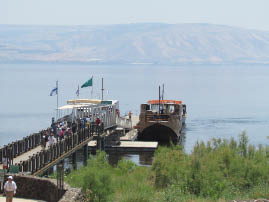
Sea of Galilee |

Sea of Galilee |
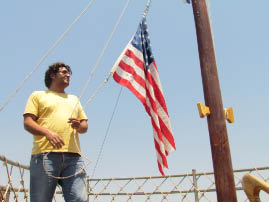 Sea of Galilee Sea of Galilee |

Sea of Galilee |

Sea of Galilee |
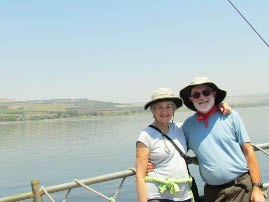
Sea of Galilee |
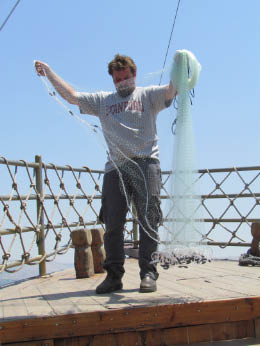
Sea of Galilee |

Sea of Galilee |
We made a most interesting stop in Kibbutz Genosar to see the Galilee Boat, an ancient 2000-year old boat. It’s also called the Jesus Boat because it dates back to the first century AD—the time of Jesus’ ministry. The boat is about 27 feet long, 7.5 feet wide and 4 feet high. It’s as impressive as the building that houses it – the expansive new wing of the Yigal Allon Centre.
In 1986, two brothers discovered the skeletal remains of a fishing vessel buried in the muddy shores of the Sea of Galilee (known as Lake Kinneret in Israel). It took a lot of hard work and 11 days for some clever archeologists, engineers and scientists to remove the ancient wooden boat from the mud without the timbers decaying. They were successful and now we’re all in awe of such a boat. There are 12 different types of wood held together by iron nails. This boat had numerous repairs – probably had a very long working life with a poor owner who couldn’t afford to replace that old boat.
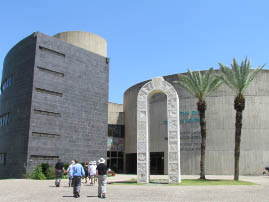
Yigal Allon Centre |
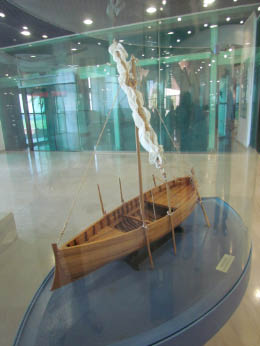
Model of Galilee Boat |

Galilee Boat |

Galilee Boat |
Down the road a little was Tabgha Benedictine Monastery, referred to as the Church of Heptapegon or Seven Springs. Starting around 30 years after Jesus' death, this area became a place of worship around a large rock upon which Jesus is said to have fed 5,000 people with 5 loaves and 2 fish. (Mark 6:31-44)
In 350 AD, the rock was used as the alter for the first church at this site, built by a Jewish nobleman from Tiberias. About 480 AD, a Byzantine church was built here with magnificent mosaic floors revealing Egyptian influence. The historic fish / bread rock was reduced in size and placed beneath the altar.
Then in 614 AD, the Persians invaded and destroyed the church. The Muslim conquest came in 636 AD and Christian activity around the lake ceased for centuries. It wasn’t until 1932 that Father Mader and his team excavated the ancient church ruins, hidden for 1300 years. In 1980-82, the ancient Byzantine basilica was reconstructed on its original foundations with most of its mosaics intact. I loved the bird design and one curious column with some sort of a scale written on it. Turns out it’s an image of a Nilometer, used to measure the flood level of the Nile for the purpose of assessing that year’s taxes. I had trouble absorbing all the facts because I running out of fuel – I was very happy to learn that lunch was our next stop.
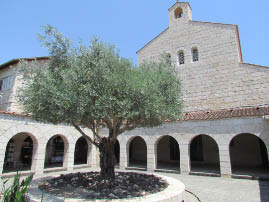
Tabgha Benedictine Monastery |
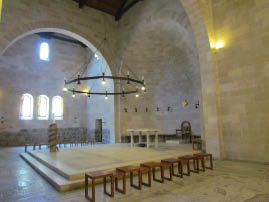
Tabgha Benedictine Monastery |
 Tabgha Benedictine Monastery Tabgha Benedictine Monastery |
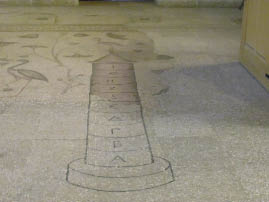
Tabgha Benedictine Monastery |
We ate grilled “St. Peter’s fish” (tilapia) by the Jordan River (or was it The Sea of Galilee). Lovely lunch -- we sat outside, right across from Don and Pat and had a big beer. The café had an enormous tree with roots growing in the bar and branches extending outside. Nice touch – one that I’ll always remember.
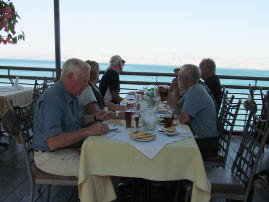
Lunch |
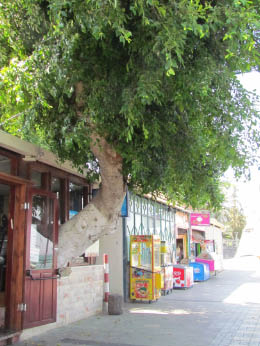
Restaurant with tree growing out |
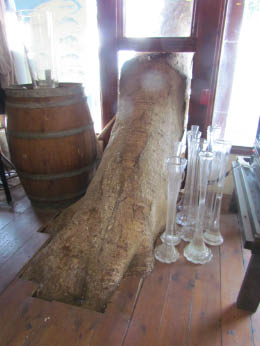
Restaurant with tree growing out |
We stopped to see the baptism spot in the Jordan River. It’s not really where John the Baptist baptized Jesus, but hey, nobody really knows where that is. Clever entrepreneurs picked a good location, one that accommodates many large tour buses. We had 30 minutes to explore the area and in my opinion, that was much too long of a stop. The Gift Shop was like a mini shopping mall stocked with items imported from China. For a fee, Christian pilgrims can rent a smock, put it over their bathing suits and head for the waters to renew their baptism vows by immersing themselves in the same waters where Jesus was baptized. It was a hot day and probably felt good. As for “saving,” didn’t look like much of that was going on. There were a lot of teens splashing around in the water, having fun and taking pictures of their pals to be posted on Facebook, I’m sure.
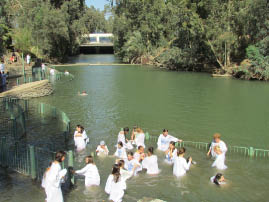
Baptized in the River Jordan |
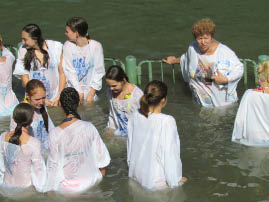
Baptized in the River Jordan |
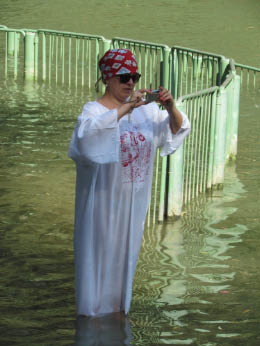
Baptized in the River Jordan |
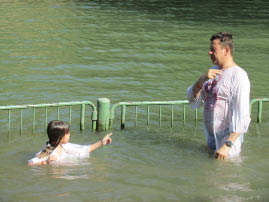
Baptized in the River Jordan |
We headed 75 miles south past Jericho and then 20 miles west to Jerusalem, climbing higher and higher over desert hills. We had come on this road once before when we traveled from Jordan to Tel Aviv. I’ll never get over the massive fortified settlements that appeared as giant condo complexes lining the hilltops, segregating the Arabs from the Jews or the Jews from the Arabs.
Just at the top of the hill, the desert ended and we descended down into green valleys. This is truly the promise land. I watched the views of Jerusalem through the bus window. Couldn’t believe I was seeing the Dome of the Rock, the Wailing Wall and lots of intense Jewish guys heading in all directions, each seemed to be on a mission.
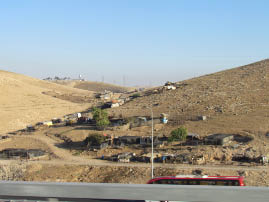
Heading toward Jerusalem |
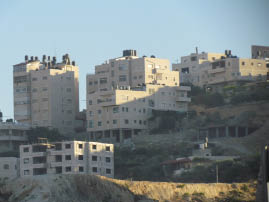
Giant condo complexes |
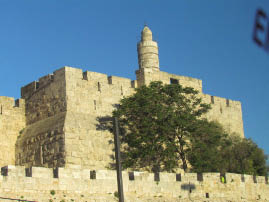 Jerusalem Jerusalem |
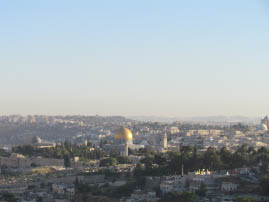
Jerusalem |
Our hotel, the Mount Zion, was extremely nice and classy. Once a hospital built by the British, it sits high on a hill, just one hill over from the ancient city of Jerusalem. Great location! Only one problem -- the bus driver had to make a tight U-turn on a busy street with cars zooming by – the only way to drop us off.
We walked half way down our hill and had dinner at the Cinema where one can watch movies and dine at the same place. We had a disappointing margarita pizza and Caesar Salad, but enjoyed our date. We checked the internet – nothing – no news is good news.
|











